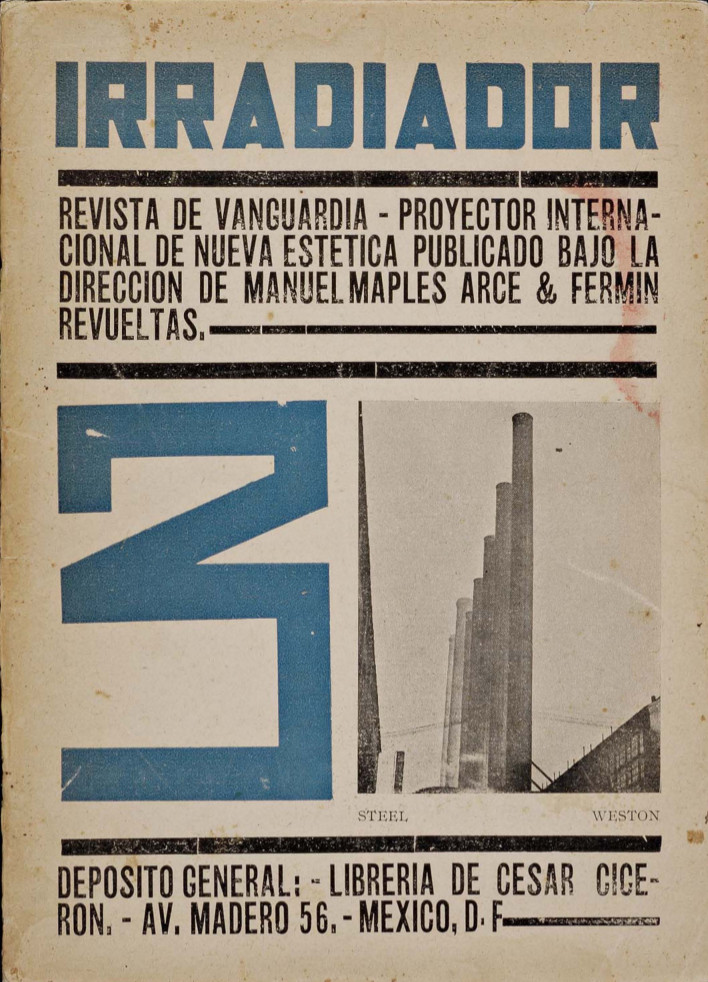Irradiador: revista de vanguardia, 1–3 (1923) [Spanish]
Filed under magazine | Tags: · art, avant-garde, concrete poetry, estridentismo, literature, mexico, poetry, politics


“The Irradiador journal was edited by the artist Fermín Revueltas (1902-1935) and was the major early voice for the Mexican avant-garde movement called Estridentismo. The journal was short-lived, and only saw three issues: September, October, and November of 1923. Still, it saw contributions by major players in the international avant-gardes, all the while staying carefully attuned to Estridentismo‘s present social concerns for post-revolutionary Mexico.
The journal’s foremost concern was the propagation of the new aesthetics in Mexico, and furthering the cultural project of the Mexican revolution. Irradiador, it promised in its motto, ‘Will make reactionaries lose sleep, and will affirm all the anxieties of the present hour.’
The journal featured woodcuts, sculptures, paintings, poems, and articles on subjects as diverse as archaeology and the petroleum industry. Its first issue contains a calligram by none other than the muralist Diego Rivera–an important endorsement for a nascent avant-garde movement like Estridentismo. It also contained a poem by the Argentine Jorge Luis Borges, which bolsters the international credibility of the Mexican movement.
Other important poets, writers, and artists to be featured over the three issues: Salvador Gallardo, Germán List Arzubide, Kyn Tanya, Juan José Tablada, and the U.S. photographer Edward Weston, whom the magazine inexplicably calls ‘Dwad Weston’ (Irradiador 3, inside cover).
The magazine’s aesthetic is a combination of Mexican images–such as Charlot’s woodcuts of indigenous workers–and modern technology, promoting the ‘Jazz Band, petroleum, New York. The city all polarized crackling in the radiotelephonic antennas…’ (‘Inaugural Irradiation’, 1).” (sourced from Kelly Scott Franklin’s blog)
Scans via The Jean Charlot Collection & the University of Hawaii at Manoa
Commentary by Evorio Escalante (video, 3 min, in Spanish)
Comment (0)David Crowley, Daniel Muzyczuk (eds.): Sounding the Body Electric: Experiments in Art and Music in Eastern Europe 1957–1984 (2012) [English/Polish]
Filed under book | Tags: · 1950s, 1960s, 1970s, 1980s, art, art history, avant-garde, central europe, east-central europe, eastern europe, electroacoustic music, experimental film, happening, sound, sound art, synaesthesia, video art, visual music

“In the aftermath of Stalinism, composers and artists in Eastern Europe were given new opportunities to experiment. New recording studios equipped with magnetic tape recorders and later, synthesizers were established, first in Warsaw in 1957 and then throughout Eastern Europe. New and often challenging forms of music were produced in these laboratories of sound.
The connections between the visual arts and experimental music were closer in the 1960s than perhaps any time before or since. Sound and image combined in artists’ films, ‘happenings’ and sounding installations. Experimental forms of notation were also created to stimulate uninhibited musical expression.
The early happenings and actions of the 1960s were associated with intellectual freedom and reform. The exhilaration of experimentation declined during the decade and in the 1970s new critical forms of art emerged which associated sound with surveillance and censorship.
This book accompanying an 2012 exhibition at the Muzeum Sztuki in Łódź explores both the optimism and the anxiety that was to be found in the experimental zone of art and music.”
The exhibition later moved to the Calvert 22 Gallery in London.
Artists: Collective Actions, Walerian Borowczyk, Andrzej Dłużniewski, Szábolcs Esztényi, László Vidovszky, Krzysztof Wodiczko, Grzegorz Kowalski, Zygmunt Krauze, Henryk Morel and Cezary Szubartowski, Eugeniusz Rudnik, Bulat Galeyev, Milan Grygar, Milan Knížák, Oskar Hansen, Zofia Hansen, Zoltán Jeney, Vitaly Komar & Alexander Melamid, Katalin Ladik, Jan Lenica, Dóra Maurer, Vladan Radovanović, Józef Robakowski, Bogusław Schaeffer.
Dźwięki elektrycznego ciała: Eksperymenty w sztuce i muzyce w Europie Wschodniej 1957–1984
Publisher Muzeum Sztuki, Łódź, 2012
ISBN 9788387937980
222 pages
David Crowley’s presentation at MoMA (video, 50 min)
Sounding the Body Electric: A Conversation (Michał Libera, Art Margins)
Accompanying audio 2-CD
PDF
PDF (exh. guide, Calvert 22 Gallery, London, 2013, added on 2023-12-27)
Thomas Ort: Art and Life in Modernist Prague: Karel Čapek and his Generation, 1911-1938 (2013)
Filed under book | Tags: · 1910s, 1920s, 1930s, art, art history, austria-hungary, avant-garde, cubism, czechoslovakia, history of literature, literature, philosophy, poetry

“In most histories of Europe before the First World War, modern life in Habsburg Mitteleuropa takes on a decidedly gloomy cast. Centering on Vienna in the twilight years of the Austro-Hungarian Empire, such accounts describe the failure of rationalism and the rise of a dangerous politics of fantasy. This book tells a different story, highlighting a generation of Czech writers and artists distinguished by their affirmative encounter with the modern world in the first decades of the twentieth century. Novelist and playwright Karel Čapek, along with other members of his cohort, embraced the possibilities of the post-Habsburg era. Tracing the roots of Čapek’s generation to cubist art and turn-of-the-century philosophy, author Thomas Ort shows that the form of modernism they championed led not into the thickets of fascism or communism but in fact closer to liberal political ideals.”
Publisher Palgrave Macmillan, 2013
Palgrave Studies in Cultural and Intellectual History series
ISBN 1137188863, 9781137188861
276 pages

